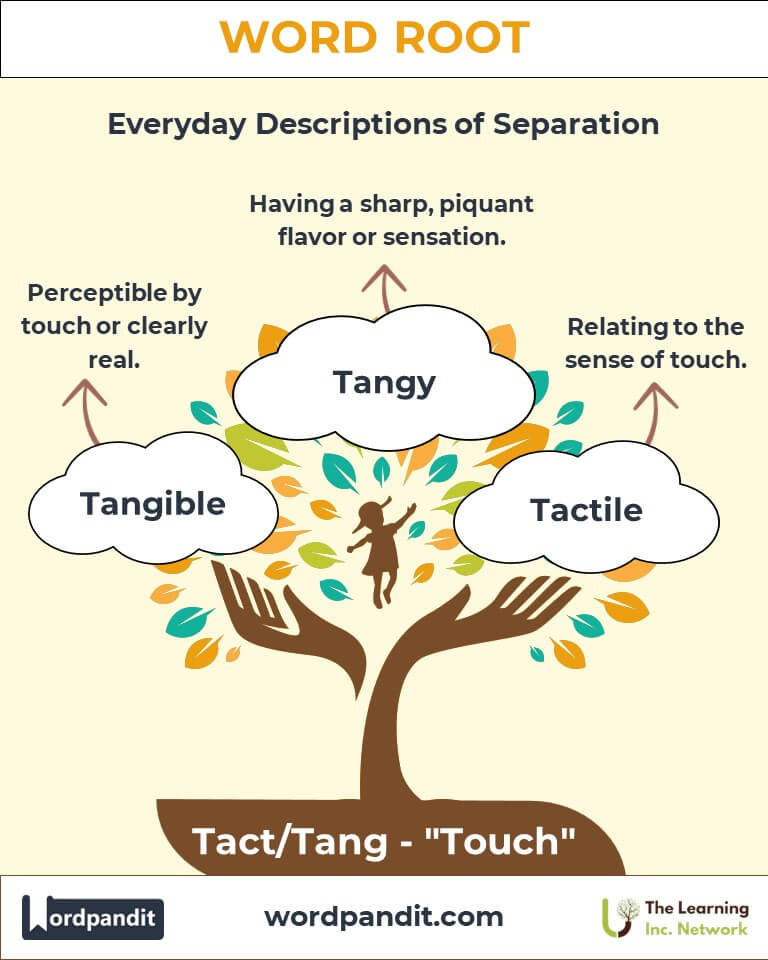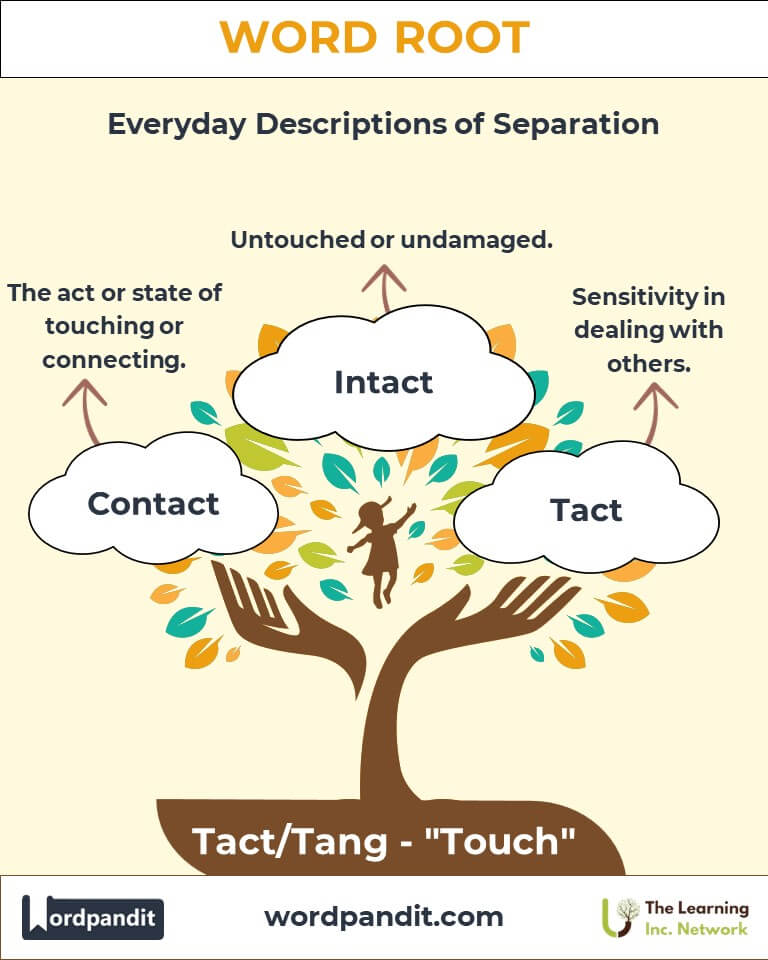Tact and Tang: The Language of Touch in Expression and Sensation
Delve into the fascinating world of the word roots "tact" and "tang," derived from Latin, meaning "touch." From interpersonal finesse to sensory experiences, these roots have left an indelible mark on the English language, weaving themselves into common and specialized vocabulary alike.

Table of Contents
- Introduction: The Essence of Tact and Tang
- Etymology and Historical Journey
- Mnemonic: Unlocking the Power of Tact and Tang
- Common Tact- and Tang-Related Terms
- Tact and Tang Through Time
- Tact and Tang in Specialized Fields
- Illustrative Story: Tact and Tang in Action
- Cultural Significance of Tact and Tang
- The Tact and Tang Family Tree
- FAQs About the Tact and Tang Word Root
- Test Your Knowledge: Tact and Tang Word Root Quiz
- Conclusion: The Living Legacy of Tact and Tang
1. Introduction: The Essence of Tact and Tang
Imagine the power of touch—not just physical, but metaphorical, as in emotional or intellectual connection. The roots "tact" and "tang" stem from the Latin word tangere, meaning "to touch." Pronounced takt and tang, they give rise to words like "contact" and "tangible," reflecting their dual nature of physical and figurative significance. Across fields like communication, science, and art, these roots anchor words that describe connection, sensation, and influence.

2. Etymology and Historical Journey
The roots "tact" and "tang" derive from the Latin verb tangere and the past participle tactus, both meaning "to touch." Their journey into English began through Old French during the Norman Conquest, later enriching terms like "intact" and "tactile." Over centuries, these roots expanded their scope, evolving from literal physical touch to concepts of perception, interaction, and understanding.
3. Mnemonic: Unlocking the Power of Tact and Tang
To remember "tact" and "tang," imagine a hand delicately touching a surface, sensing its texture.
Mnemonic Device:
"Tact touches hearts, Tang touches things."
4. Common Tact- and Tang-Related Terms
- Contact (kon-takt):
Definition: The act or state of touching or connecting.
Example: "Maintaining eye contact shows confidence in communication." - Tangible (tan-juh-buhl):
Definition: Perceptible by touch or clearly real.
Example: "The tangible results of the project impressed the stakeholders." - Intact (in-takt):
Definition: Untouched or undamaged.
Example: "The artifact remained intact despite the centuries of wear." - Tactile (tak-til):
Definition: Relating to the sense of touch.
Example: "Braille is a tactile system that enables the visually impaired to read." - Tangy (tan-gee):
Definition: Having a sharp, piquant flavor or sensation.
Example: "The tangy lemonade was the perfect refreshment on a hot day."
5. Tact and Tang Through Time
- Tactile (16th Century): Initially used to describe touch in a physical sense, tactile now extends to describing art, technology, and sensory experiences.
- Contact (17th Century): Originally referring to physical touch, it has evolved to include emotional and social interactions, such as staying "in contact" with someone.
6. Tact and Tang in Specialized Fields
Psychology
Tactile learning: Refers to hands-on methods, engaging the sense of touch.
Technology
Tactile feedback: Devices like smartphones rely on tactile feedback to improve user experience.
Culinary Arts
Tangy: Refers to sharp or piquant flavors in food, adding zest and enhancing taste profiles.
7. Illustrative Story: Tact and Tang in Action
Sophia, a therapist, knew the importance of tact—both literal and figurative. She used tactile objects to help her patients ground themselves during stress, while her ability to tactfully address sensitive topics earned their trust. Meanwhile, her chef brother, Daniel, experimented with tangy citrus flavors in his dishes, creating a unique sensory experience. Together, their pursuits highlighted the multifaceted power of touch.
8. Cultural Significance of Tact and Tang
In literature and daily life, tact signifies diplomacy and emotional intelligence, qualities celebrated in many cultures. Tang, on the other hand, embodies zest and vitality, often used metaphorically to describe lively personalities or experiences.

9. The Tact and Tang Family Tree
- Tag (Latin: to touch lightly):
- Tagline: A brief, catchy phrase.
- Tag: A label or identifier.
- Tangere (Latin: to touch):
- Contingent: Dependent on touch or conditions.
- Intangible: Not perceptible by touch.

10. FAQs About the Tact and Tang Word Roots
Q: What does "tact" mean in communication?
A: Tact refers to sensitivity or skill in dealing with others, especially in delicate situations. It stems from the idea of "touch" as a metaphor for handling interpersonal interactions carefully. For instance, when someone addresses a sensitive topic without offending, they are said to have tact.
Q: Is "tang" always related to taste?
A: While "tang" is commonly associated with sharp or piquant flavors, it also extends metaphorically to describe anything sharp or distinctive. For example, the "tang" of a remark refers to its sharpness or wit, while "tangy air" might describe a crisp or bracing atmosphere.
Q: How are "tactile" and "tangible" different?
A: Tactile pertains specifically to the sense of touch. It describes textures or physical sensations (e.g., "The fabric has a pleasant tactile feel."). Tangible refers to something real or concrete, whether physical or metaphorical (e.g., "The benefits of the project are tangible and measurable.").
Q: What is the origin of "contact"?
A: The word "contact" comes from the Latin contactus, meaning "to touch together." Over time, it has evolved to mean both physical touch and figurative connections, such as staying in communication with someone.
Q: What is "intact," and how does it relate to touch?
A: The word "intact" literally means "untouched" or "not damaged." Its root highlights the idea of something remaining whole because it has not been physically or metaphorically "touched" or altered.
Q: What does "tactile feedback" mean in technology?
A: Tactile feedback refers to the physical sensations created by devices, such as vibrations in a smartphone, to simulate touch. This technology enhances user experience by mimicking the sensation of pressing buttons or interacting with real objects.
Q: Why is "tact" important in social interactions?
A: Tact allows people to navigate sensitive conversations without causing offense. It demonstrates emotional intelligence and respect for others’ feelings, making it an essential skill in personal and professional relationships.
11. Test Your Knowledge: Tact and Tang Mastery Quiz
1. What does "tangible" mean?
2. Which word means "undamaged or untouched"?
3. What does "tactile" primarily describe?
4. What is the primary meaning of "contact"?
5. What does "tangy" mean in culinary terms?
12. Conclusion: The Living Legacy of Tact and Tang
The roots "tact" and "tang" remind us of the profound importance of touch, whether physical, emotional, or intellectual. As language evolves, these roots continue to inspire words that connect us to the world and each other, demonstrating that the essence of touch transcends boundaries.












